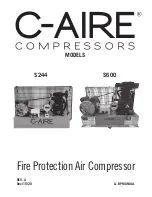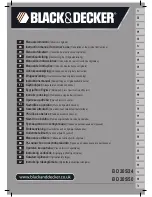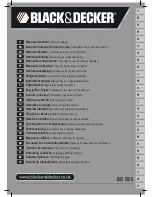
21
English
2. Pull ring on safety valve allowing air to bleed from the tank
until tank pressure is approximately 20 PSI. Release safety
valve ring.
3. Drain water from tank by opening drain valve (clockwise) on
bottom of tank.
WARNING: Risk of bursting. Water will condense in the tank. If not
drained, water will corrode and weaken the tank causing a risk of tank
rupture.
NOTICE: Risk of property damage. Water from tank may contain
oil and rust which can cause stains.
4. After the water has been drained, close the drain valve
(counterclockwise). The air compressor can now be stored.
NOTICE: If drain valve is plugged, release all air pressure. The
valve can then be removed, cleaned then reinstalled.
AIR COMPRESSOR PUMP OIL (FIG. 3, page 9)
NOTICE: Risk of property damage. Use air compressor oil only.
Multi-weight automotive engine oils like 10W30 should not be
used in air compressors. They leave carbon deposits on critical
components, thus reducing performance and air compressor life.
NOTICE: Use full synthetic, non-detergent air compressor oil.
NOTICE: Crankcase oil capacity is approximately 32 fluid
ounces (946 ml).
CHECKING OIL
1. The oil level should be to the middle of the sight glass (X).
2. If needed, remove oil fill plug (Y) and slowly add oil until it
reaches the middle of the sight glass.
CHANGING OIL
WARNING: Drain tank to release air pressure before removing the oil fill
plug or oil drain plug.
1. Remove the oil fill plug (Y).
2. Remove the oil drain plug (W) and drain oil into a suitable
container.
3. Replace the oil drain plug (W) and tighten securely.
4. Slowly add air compressor oil until it reaches the middle of
the sight glass (X).
NOTICE: When filling the crankcase, the oil flows very slowly
into the pump. If the oil is added too quickly, it will overflow and
appear to be full.
CAUTION: Overfilling with oil will cause premature pump failure.
Do not overfill.
5. Replace oil fill plug (Y) and tighten securely.
BELT REPLACEMENT
WARNING: This unit starts automatically. ALWAYS shut off and unplug
the air compressor, and bleed all pressure from the system before
servicing the air compressor, and when the air compressor is not in use.
Do not use the unit with the shrouds or belt guard removed. Serious injury
could occur from contact with moving parts. Hot surfaces. Risk of burn.
Pump head, and surrounding parts are very hot, do not touch (see the Hot
Surfaces identified in Fig. 4, page 9). Allow air compressor to cool prior to
servicing.
















































